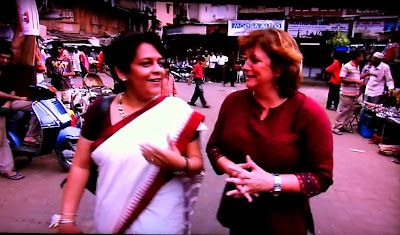- By Deepa Krishnan
This week I'm feeling like a TV star :)
I was on iTV in the UK, in a show called A Passage Through India. The show had a celebrity hostess, Caroline Quentin, and she travelled through many cities, including Mumbai.

Episode 2 of A Passage Through India, iTV UK
I took Caroline around Mumbai in a taxicab that had been specially arranged for the shoot. We were both wearing maroon, and the red upholstery of the cab gave it a "this is India" look.

How do you like my "Sonia Gandhi" saree? :) :)
The saree is actually a khadi cotton, that I bought from Sundari Silks in Madras. And aren't the pearls gorgeous? They're from Cochin, a gift from my husband on our last Kerala holiday. The ear-rings are from Delhi. So the only thing "Mumbai" about this is my saree blouse and my lipstick!
In the initial part of the programme, we drove around the city must-see's and I gave her an introduction to the origins of the city and how the East India Company finally arrived here.
After the initial driving around, we went to see the city's bazaars. This is Caroline and me at Chor Bazaar where I was talking about two of my pet themes, recycling and the never-say-die spirit of Mumbai's migrants.

Car parts and metal recycling near Chor Bazaar
Sharing a laugh over hair colour and male vanity
Caroline is absolutely lovely; she is warm, outspoken, funny and intelligent. A total delight to be with. We had loads of laughs; some of which made it to the show, and some of which didn't (thank god). In this part of the programme, we were discussing what colour hair we preferred in men :)
We also went to Mangaldas Market, where we found this family shopping for a wedding.

Caroline Quentin at Mangaldas Market, doing her thing - making everyone laugh!
There were two cousins, both getting married the same day, and both girls were at the market looking for their trousseau. Everyone was very friendly and they all had a good laugh at Caroline explaining how she did the dandiya-raas at Navratri.
We found a lot of stray dogs in Bhuleshwar and Chor Bazaar. Caroline loves dogs; she has 4 dogs at home; so we talked a bit about the problems of having such a huge stray population, and about local non-profits that work in the area of stray dog welfare. Later in the show, she went off with a vet to see Welfare of Stray Dogs in action. She also went to see Mallakhamb being practiced; and she went shopping with a Bollywood starlet and learnt some dance moves.
Towards the end of the show, we went to the Taj for drinks. It was a hot day, and this was a welcome break from the bazaars.

"Mumbai's heart lies in its bazaars", I'm saying.
All in all, a fun day spent with a lovely lady; and a chance to showcase my city, minus the usual cliches. I quite enjoyed myself!






